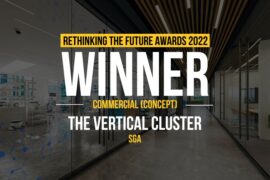‘We shape buildings, thereafter they shape us’- Winston Churchill. A prison has always been conceived as a dark, dreadful and secretive facility by the outside world. All of the practices that are being carried out within the prison premises are unknown by many. Reformation and rehabilitation of prisoners and the effect of the prison environment on their psychology while they are at the prison and after they are released has always been a major concern.
Architect: Mariya Danawala
University: Allana College Of Architecture, Pune
Country: India
TOPIC JUSTIFICATIONWith the numbers of crimes increasing by the day, the criminal count is increasing too. Rehabilitation does not seem to be well attained due to persistent crimes committed by the convicted persons even after being punished and rehabilitated formerly. Another concern being, there is no acceptance of these prisoners back into the society after being released, which may have extensive amounts of impact on their psychology. Punishment is not the sole aim, reformation and rehabilitation follow it too.
Every prisoner is a human being, with the same joy and sorrow, laughter and tears, hopes and aspirations as any other human being and should be treated with the same dignity, respect and decency as any other human being. The very fact that a prisoner has been sentenced to imprisonment once already and has suffered enough physically, mentally and emotionally implies that he is not to be incarcerated through imprisonment once again.
Treating every prisoner with kindness and compassion, empathy and sensitivity in the same manner as late V. Shantaram, the outstanding Marathi and Hindi film personality had demonstrated in his classic film, ‘Do Aankhen Barah Haath’ in the 60’s.
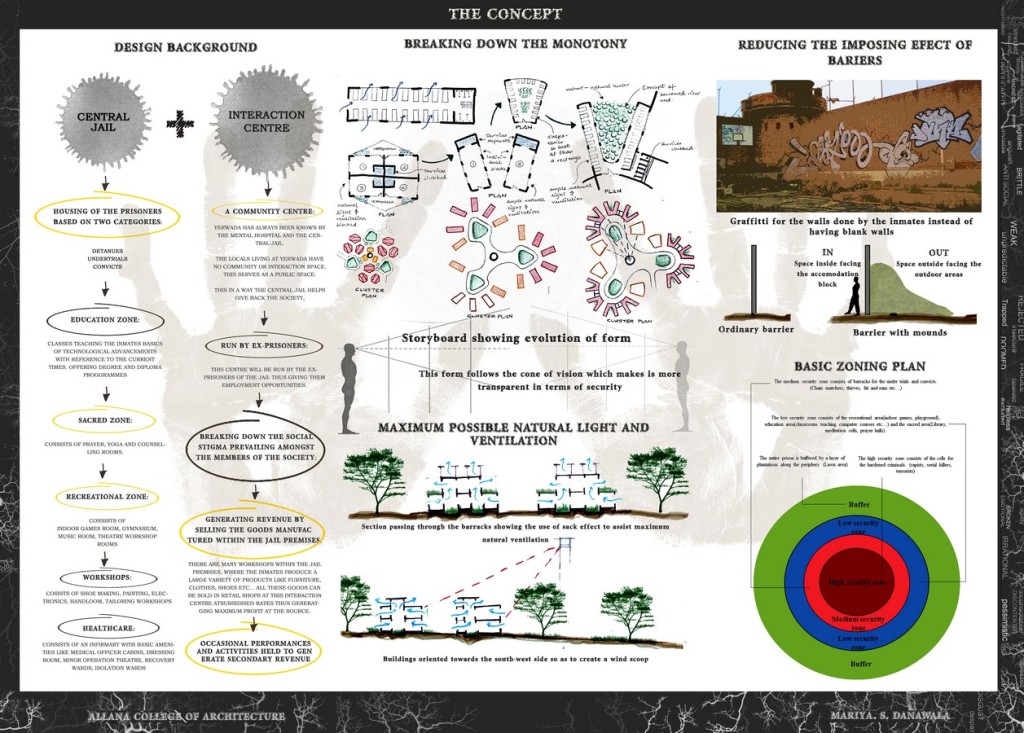
OBJECTIVE: Prisons have been one of the most neglected sectors in terms of architecture. Most of the prisons in our country have been functioning the way they used to since the British times. In terms of infrastructure the prisons need tremendous up gradation. As one enters a space, whether positive or negative, he is psychologically affected by that space.
Prisons are not just meant to punish the convicted, but also make them feel blameful of the offense he/she has committed by rehabilitation. The prison environment should be designed in a way so as to make the inmates repent, culpable, sinful, grounded and remorse over the sins they committed. And reform them in a way so as they do not get back to committing those mistakes once again The prisons that are functioning at present have various psychological impacts on the convicted which may or may not end up sculpting the individual into the desired personality.

This project aims at providing a conducive and humane environment to the prisoners, in order to positively influence their thought process and instill within them a sense of hope and faith towards the future to come. A positive environment will help motivate them and give them a direction towards the right path.
There also is a proposed interaction center adjacent to the prison which will consist of retail stores run exclusively by the ex-prisoners. The retail stores will sell goods manufactured within the prison premises and will in turn provide employment opportunities to the ex-prisoners. Instilling hope, faith into the mind of every prisoner that despite the trying circumstances under which the prisoner was brought into the prison, all is not lost and a life of dignity and decency can be started afresh.
This approach is an experiment which also focuses of breaking the sense of social stigma prevailing amongst the members of our society towards the prisoners after they have been released back into the society.
TRANSITIONAL SERVICES TO PREPARE PRISONERS FOR COMMUNITY RELEASE: A very important question is, what happens to the prisoners after completing their sentence? Where do they go? What do they do? This is when the following comes into consideration:
-Persons who return home from prison face personal, social, and structural challenges that they have neither the ability nor resources to overcome entirely on their own.
-Post-release success depends on the nature and quality of services and support provided in the community, and here is where the least amount of societal attention and resources are typically directed. This tendency must be reversed.

-By providing such a transitional space, between the prison premises and the prisoner’s home, it will help guide the inmate, give him a sense of progression and will make him look forward to being rehabilitated and reformed into a completely different being who has learnt from his mistakes and is ready to contribute constructively to the society in some way after being released.
-This transition space could have various activities and programmes which could help in the development of the inmates into responsible citizens of our country:
-This project aims at reforming the purpose of a prison which currently serves only as a place for punishment. It also aims at reshaping the inmates into better individuals who in turn can help contribute and serve back to the society.
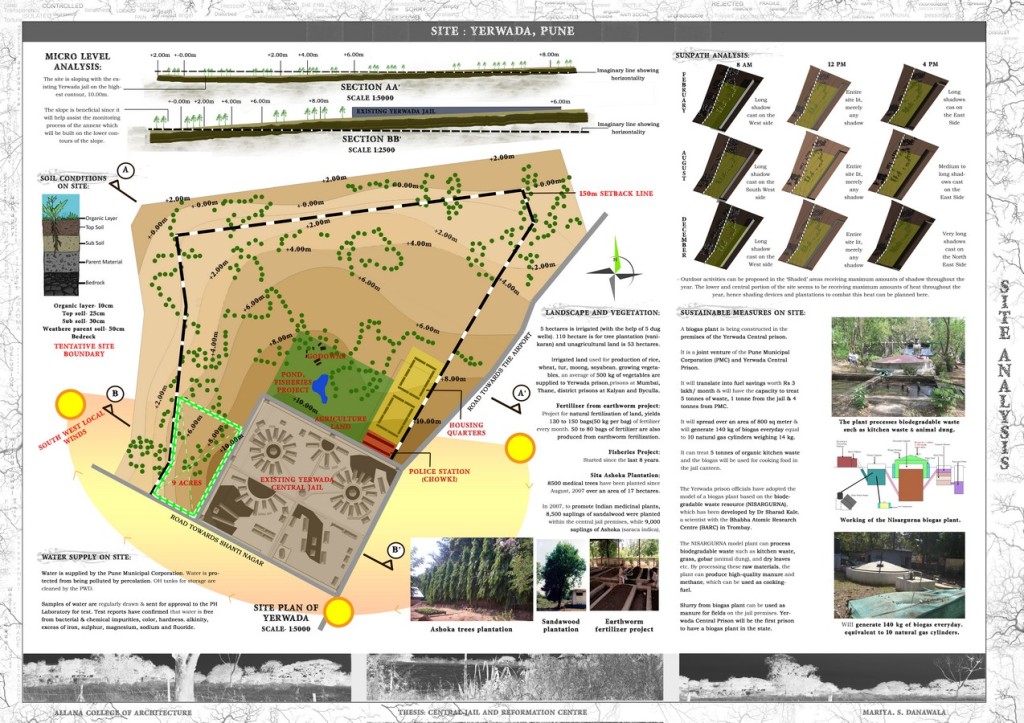
SITE SELECTION: This project targets the design urgency at the Yerwada Central Jail, Pune which is facing the problem of overcrowding.
Sanctioned capacity of Yerwada=2449
No. of convicts = 1225
No. of under trials = 2002
Detenues =30
Actual capacity = 3257
Hence, no room for 808 inmates approx. = 1000 (Considering future additions)
Considering,
60% of 1000 = 600 under trials
36% of 1000 = 360 convicts
4% of 1000 = 40 detenues
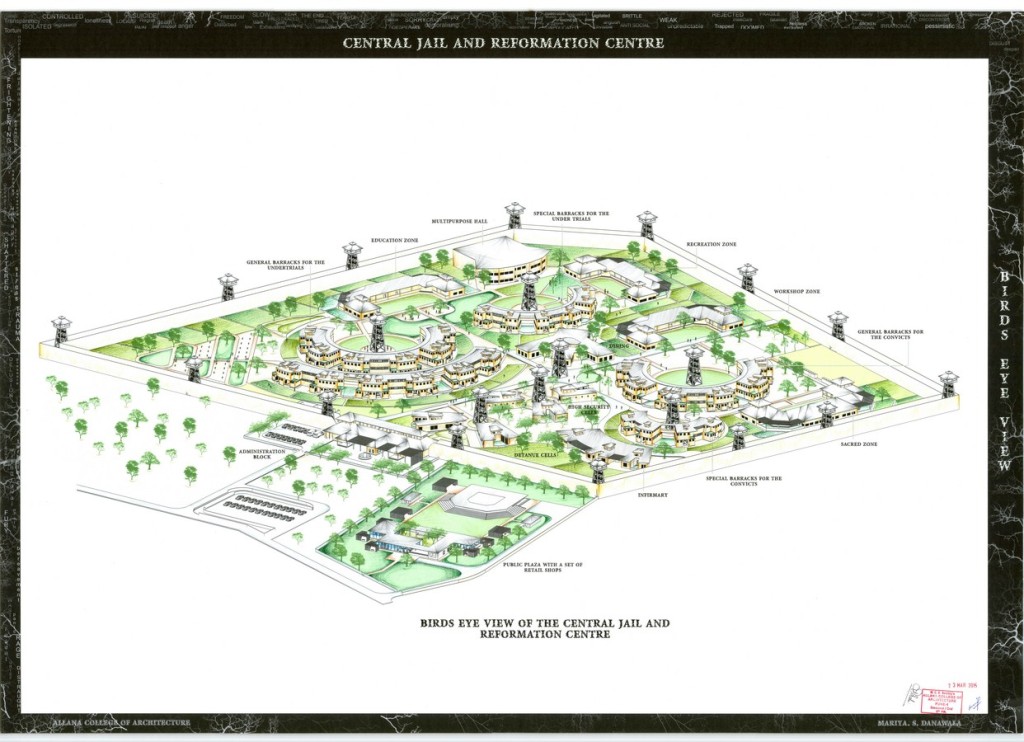
DESIGN BRIEF:
The design brief includes areas such as:
- Administration facilities limited to the requirements of the annex
- Typologies of accommodation to tackle the problem of overcrowding
- Dining and kitchen facilities
- Infirmary or health center
- Education zone- Classrooms where various subjects will be taught
- Sacred zone- Spaces like prayer halls, meditation cells, library
- Recreational zone- Indoor games, informal amphitheater, sports ground etc…
- Interaction center- A set of retail stores selling goods manufactured within the prison premises run exclusively by the ex- prisoners
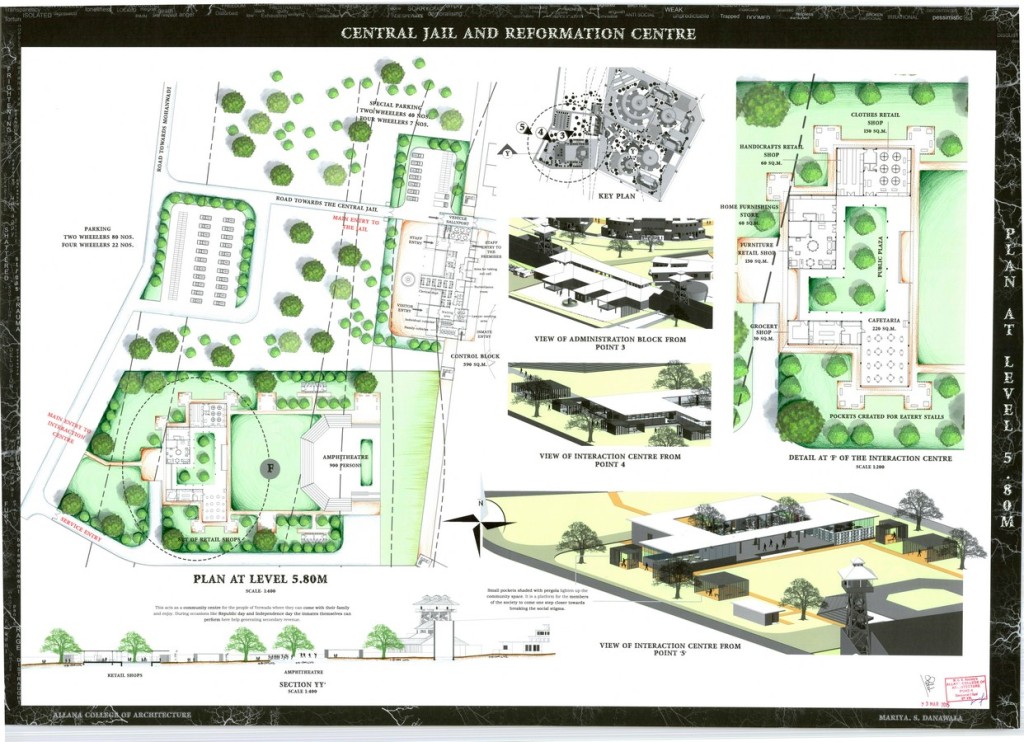
DESIGN PRINCIPLES:
-A zoning hierarchy has been followed where the highest security area is towards the centre, followed by the medium security zone which is further followed by the low security zone. The low security zone is surrounded by a buffer zone of plantations. The high security zone consists of the cells for the hardened criminals (rapists, serial killers, terrorists). The medium security zone consists of barracks for the under trials and convicts. (Chain snatchers, thieves, hit and run etc…) The low security zone consists of the recreational area (indoor games, playground), education area (classrooms teaching computer courses etc…) and the sacred area (Library, meditation cells, prayer halls).
-Important spaces like the cells, reformation and work areas are designed in a way so as to help the inmate feel the sense of reformation and rehabilitation. Since these are the places where the inmate spends maximum of his time, it was imperative to use these areas in order to positively influence the psychology of the inmates. This has been done with the assistance of the various materials, textures, colors, furniture and lighting used in the facility.
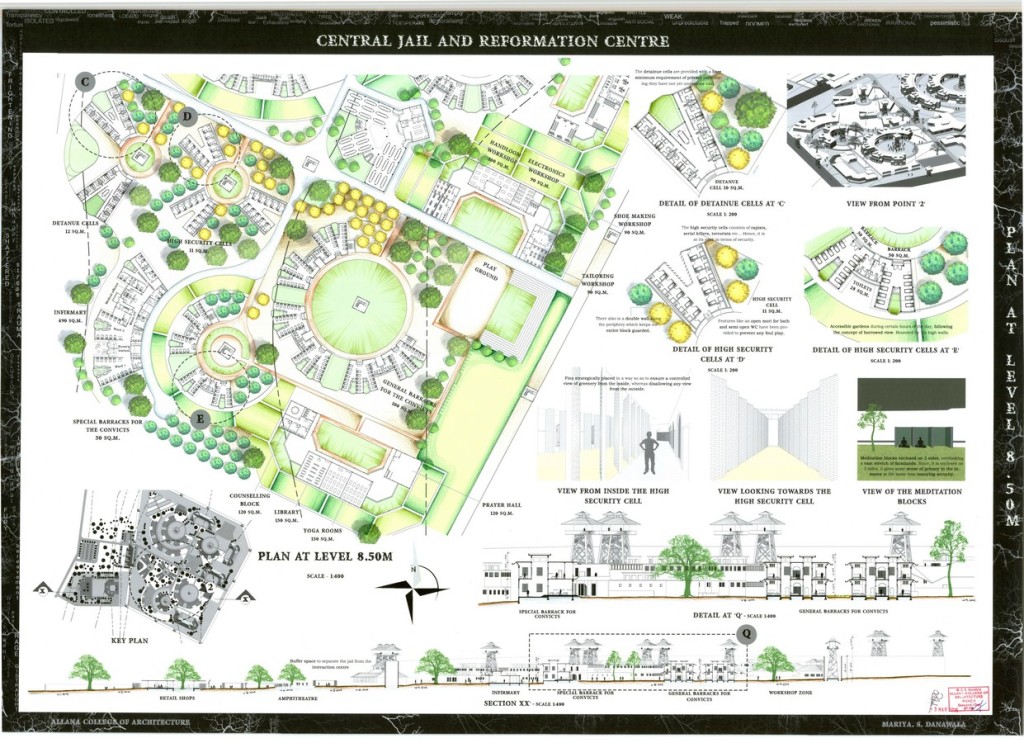
-The roads and pathways have been designed so as to instill discipline amongst the prisoners. The central intersections form circular platforms that act as assembly grounds for them.
-The entire complex has evolved in a radial manner. The prime purpose was to have no blind spots or edges. This distributed radial planning (Inspired by the Panopticon) helped achieve the same.
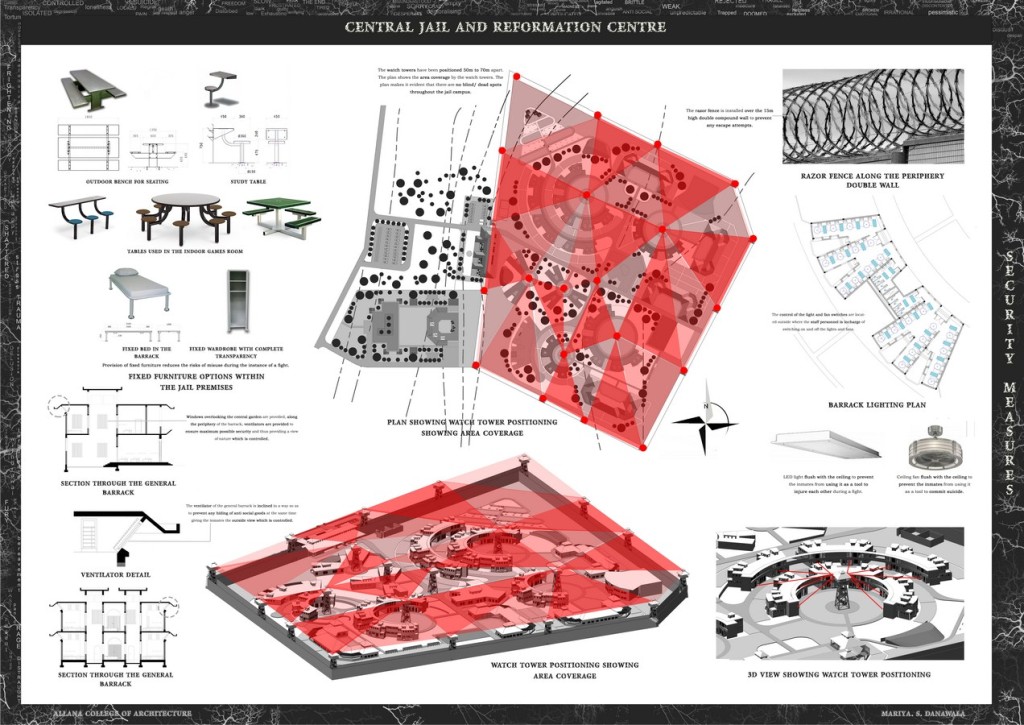
-All the cells and barracks overlook individual open gardens. This idea is inspired by the concept of ‘A Borrowed view’ from Japanese landscape. In this case the inmates can view a beautiful garden from the inside of their barracks and are allowed controlled access to it.
-Efforts have been made to achieve maximum possible natural light and air by incorporating clerestory windows and orienting the barracks towards the South-West direction.

-96% of the landscape within the premises is productive i.e. farmlands. Farming helps keep the inmates occupied. Since it takes place within the premises; it is convenient from the security point of view as well.
-The watch towers have been designed in a very transparent way which reflects the identity of the jail.
Mariya Danawala
Mariya is an Architect and UX Designer born in the city of Mumbai, India. She is driven by mystery, curiosity and compassion and spends most days contemplating the design of a more thoughtful world. She earned a bachelor’s degree in Architecture from Allana College Of Architecture, University Of Pune. She topped her architectural thesis project, ‘Central Jail and Reformation Center’ in 2015. In the final year of architecture she stood 6th in the University Of Pune and was given a Jury Recommendation Award by AESA for her thesis topic.
Her experience working on this thesis subject not only made her grow as a designer, but also as an individual. She interacted with multiple prisoners (Some who were not even guilty of the charges!), visited various prisons across the country, ate the food that they eat, purchased goods that they make, interviewed multiple police personnel and did everything that she never imagined she would! She hopes to continue working on similar social projects towards making the world a much better place.


